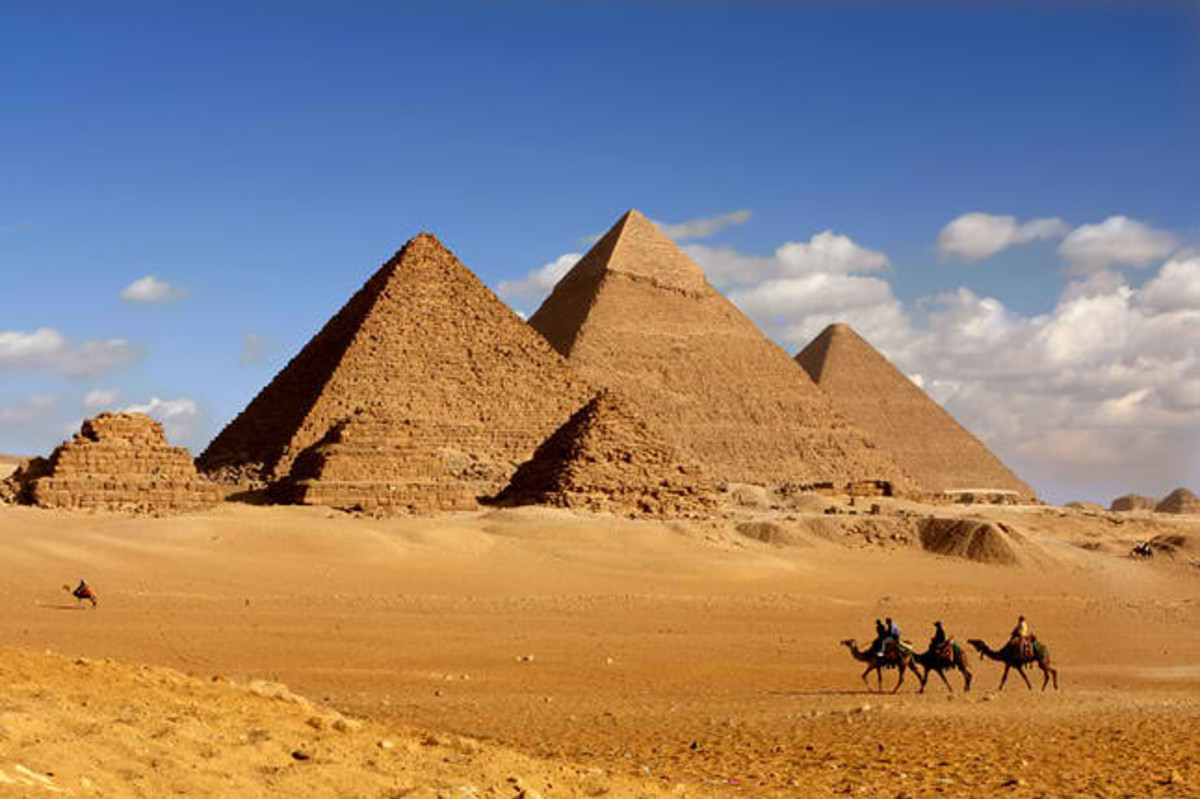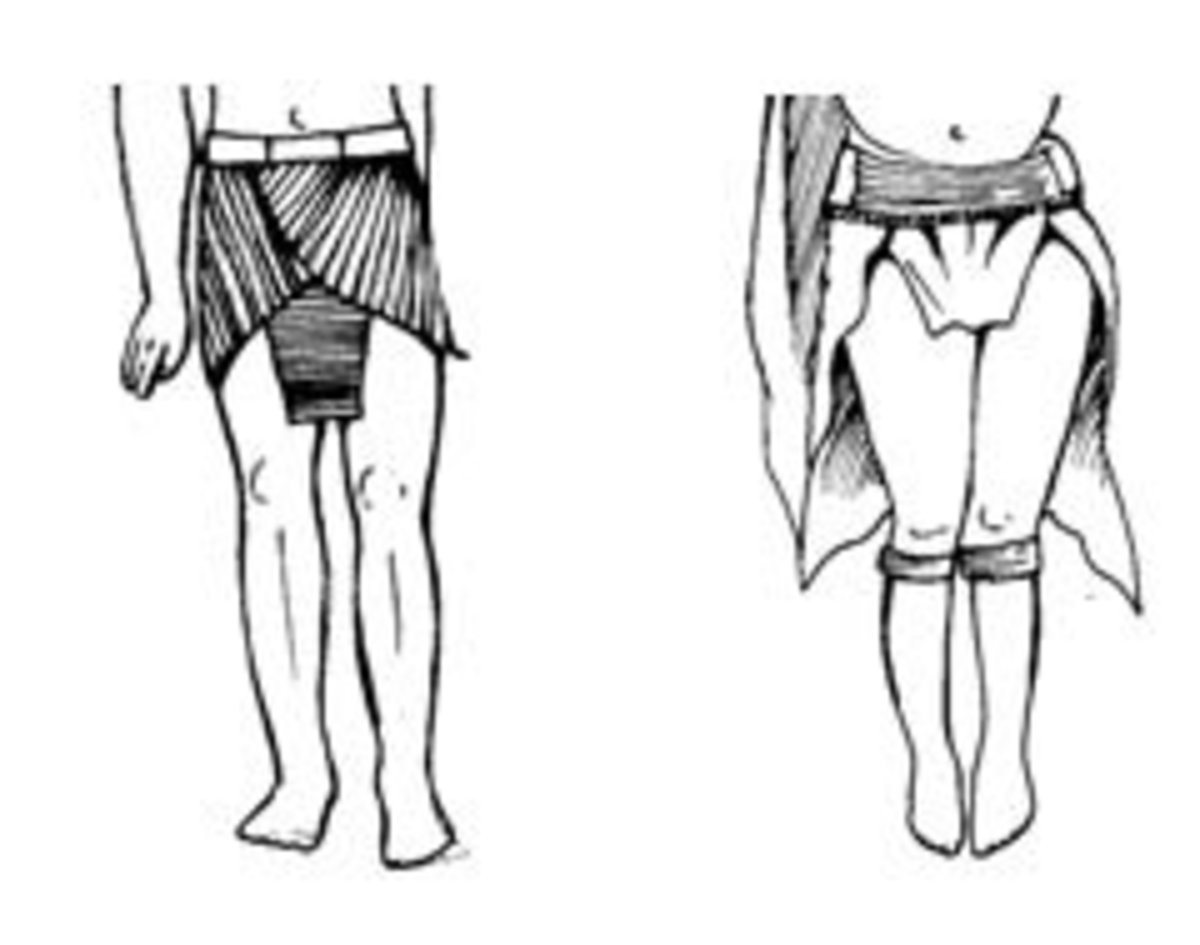How did the Ancient Egyptians Construct the Pyramids of Giza?

The pyramids at Giza have fascinated and mystified observers for millennia. How could a civilization 4,500 years ago — one that that had yet to invent the wheel — build structures such as these, using stone blocks weighing several tons each?
The truth is, we really don't know, although several theories have been offered. Before examining these theories, however, let's take a brief look at the pyramids themselves.

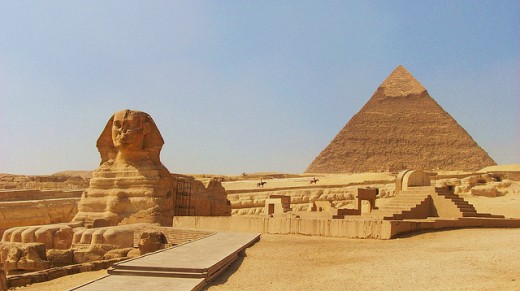
The Pyramids at Giza
The Giza plateau contains three large pyramids and several smaller ones. It is also the site of the sphinx, the famous giant statue of a lion with a man's head, the purpose of which is unknown.
The larger pyramids contain the tombs of the pharaohs Khufu, Khafre and Menkaure, and the smaller pyramids hold the tombs of the pharaohs' wives. Other sites and structures making up the Giza complex (also known as the Giza Necropolis) can be seen on the map below.
The largest of the three pyramids, known as the Great Pyramid or Khufu's Pyramid, is not only the oldest of the seven wonders of the ancient world, but also the only one still standing. It would have been the most challenging of all the pyramids to build, and most theories focus specifically on construction of the Great Pyramid.
The Giza Necropolis
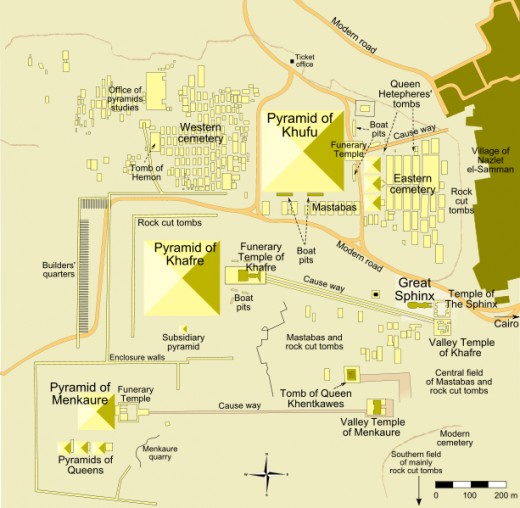

Problems of Pyramid Construction
Problems to be solved regarding construction of the pyramids at Giza include:
- Quarrying the large stone blocks
- Moving the blocks to the construction site
- Lifting the blocks to the necessary heights
- Positioning the blocks with great precision
The biggest of these is the problem of lifting the stones. Quarrying the stone would have been possible with the copper and stone tools discovered at quarry sites, and a team of about a dozen men would have been able to drag the stones to the construction site, possibly with the help of wooden sleds. It would be difficult, labor-intensive work, but not impossible.
As most of the limestone actually came from a quarry at Giza, the majority of blocks were dragged a much shorter distance than is commonly believed. But how were the ancient Egyptians then able to raise these heavy stones hundreds of feet off the ground? The most likely methods involve either the use of a crane-like machine, similar to the shaduf that was used to take water from the Nile for irrigation, or a ramp system.


Herodotus: Ancient Egyptian Technology
In 450 BC, Greek historian Herodotus published the first known account of how the pyramids might have been built. Visiting Egypt, he was told by Egyptian priests that they were built as a series of flat tiers, and on each tier were crane-like machines made of wood that lifted the stones from one level to the next. According to Herodotus' account, after all the tiers were completed the pyramid was finished from the top down with a smooth outer layer of polished limestone. Herodotus was told that 100,000 slaves labored for 20 years to complete Khufu's Pyramid.
While it would have been possible to lift the heavy stones with wooden cranes, it is doubtful that there was enough lumber available to the Egyptians to build the number of cranes that would be required. It's also unlikely that such cranes could have been moved and operated quickly enough to have completed the Great Pyramid during Khufu's lifetime. The pyramids were already 2000 years old when Herodotus wrote of them, and Egyptologists no longer consider his account to be accurate.

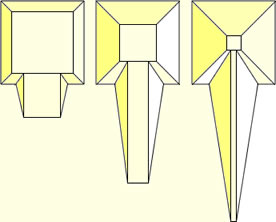
Single Ramp Theory
Another method of raising stones to great heights would be a system of ramps, on which workers could drag stones to their final destinations. A number of ramp systems have been suggested.
The Single Ramp Theory proposes that one big ramp, which was continually made larger to match the height of the pyramid as it grew, was used. The main problem with this theory is that if the ramp is too steep it becomes impossible for workers to pull stones up. A ramp built at a workable angle would have to be about a mile long to reach the top of the pyramid.
The ramp would be a construction project at least as big as the pyramid itself — assuming sufficient materials were even available. It would also require a stretch of land a mile long that was level and firm enough to support the ramp. There are few places on the Giza plateau where the ramp could have been placed, and no archaeological evidence has been found that such a ramp was ever built.

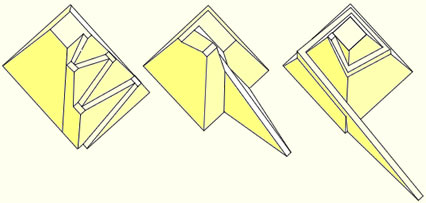
Spiral Ramp Theory
To overcome the problems inherent in the Single Ramp Theory, a number of different ramp systems and variations have been suggested. Probably the most commonly-accepted theory today proposes a ramp, or series of ramps, spiraling around the structure of the pyramid. Upon completion of the pyramid, these ramps would have been removed.
The total distance one would have to travel to reach the top of the pyramid on a spiral ramp would be the same as the straight ramp - about a mile - but very little additional land is required, as most of the ramp system rests on the pyramid itself. This also reduces the amount of material required.


Problems With the Spiral Ramp Theory
This theory is not perfect either, however. There is a limit to how wide a ramp could be and still be safely supported by the external structure of the pyramid. Such narrow ramps might not leave enough room for workers — who have to be in front of a stone in order to pull it up the ramp — to drag a stone all the way to the corner, and then turn it so that it could be pulled up the next section of ramp.
Such a system of ramps would also make it very difficult to make the observations and measurements required to ensure that the sides of the pyramid meet at precisely the right point at the top. The progress of all sides and corners of the pyramid would need to be continually monitored throughout the construction project. A system of ramps spiraling around the structure would make this very difficult.

Summary: Pyramid Construction Theories and Their Drawbacks
Construction Theory
| Drawbacks
|
|---|---|
Machines (as described by Herodotus)
| Lack of lumber to build sufficient machines; inability of machines to work at necessary speed
|
Single Ramp Theory
| Ramp would be 1 mile long; no stretch of ground level enough; no evidence of such a ramp
|
Spiral Ramp Theory
| Ramps may not be wide enough; would interfere with sighting required for proper alignment
|


Jean-Pierre Houdin: Internal Ramp Theory
French architect Jean-Pierre Houdin has come up with a promising theory that addresses many of the problems other theories leave unsolved. His theory combines a straight external ramp with an internal spiral ramp.
Houdin theorizes that a straight external ramp was used for the lower portion of the pyramid, with an internal ramp system being used at the point where an external ramp is no longer feasible. Putting the spiral ramp inside the structure avoids the problems introduced by an external spiral ramp.
To solve the problem of turning the stones at the corners of the ramp, Houdin believes that the corners of the pyramid were left open. This would not only allow air and light into the ramp system, but also provide space for turning the stones. This could also help explain the crane-like machines described by Herodotus. It may have been at these corners that such devices were used to help turn the stones.
The external ramp helps solve another long-standing mystery, one related to the pharaoh's burial chamber itself.

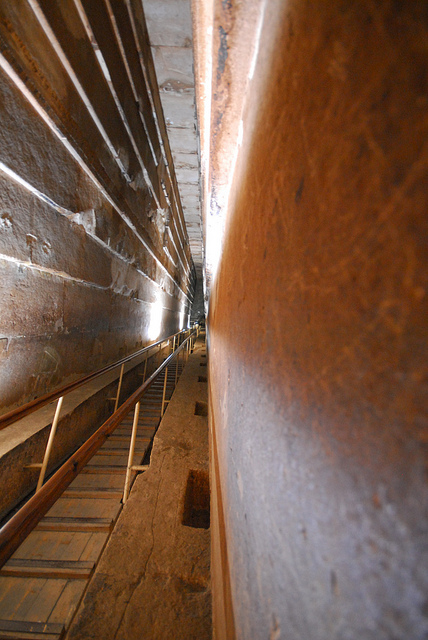
Burial Chamber: Granite Blocks
Deep within the pyramid is the burial chamber where Khufu's body was laid to rest. Unlike the rest of the pyramid, which was constructed primarily of limestone, the burial chamber is made of granite. While the average weight of the limestone blocks is about 2.5 tons, the blocks of granite weigh as much as 80 tons each. No theory has satisfactorily addressed the problem of raising such massive blocks. Houdin has proposed a solution for this mystery, as well.
Houdin believes that the external ramp was used in combination with a system of counterweights to raise the granite blocks for the burial chamber. There is a large chamber inside the pyramid, which archaeologists have named the Grand Gallery, the purpose of which never been understood. Houdin has discovered that this chamber is the right size, shape and position to have housed a series of counterweights of sufficient size and weight to pull the granite blocks up an external ramp to the burial chamber.

Pyramid Stones Cast, Not Cut?
A theory proposed by Professor Michel Barsoum suggests that the stones making up the Great Pyramid were not cut and carried into place at all, but were poured from a cement-like compound that could have been created from raw materials available to the ancient Egyptians.
The theory fails to address the problem of lifting the granite blocks used for the burial chamber, but it is an interesting alternative that answers many other questions. An official website for Dr. Barsoum's pyramid research is hosted by Drexel University in Philadelphia.
Internal Ramp Theory: The Evidence
Houdin has amassed a sizeable body of evidence to support his theory. For example, there is evidence that internal ramps were used by the ancient Egyptians on other structures, including the sun temple of King Ni-Userre, which was built only about 100 years after the Great Pyramid. Houdin has also used advanced 3D software to show that such a system could exist inside the Great Pyramid without running into any of the chambers and passageways that are known to exist.
The best piece of evidence supporting Houdin's theory, however, is a survey of the Great Pyramid done in 1986 by a French team. The team used a technique known as microgravity, which measures the density of an object. A low density indicates an open space. The microgravity survey appears to show an area of open space spiraling around the inside of the pyramid. This result mystified the French team, who chose not to publish it. Upon hearing of Houdin's theory, however, the team has chosen to make these results, which appear to confirm the theory, available.
Poll: Internal Ramp Theory
Do you think Houdin's Internal Ramp Theory is correct?
Permission is needed from the Egyptian government before any further studies can be done to help prove the existence of the internal ramp system. It may be years before such a study is proposed and approved. In the meantime, Egyptologists consider Houdin's internal ramp theory to be an intriguing possibility, but most believe that more evidence is needed before the theory can be accepted as fact.

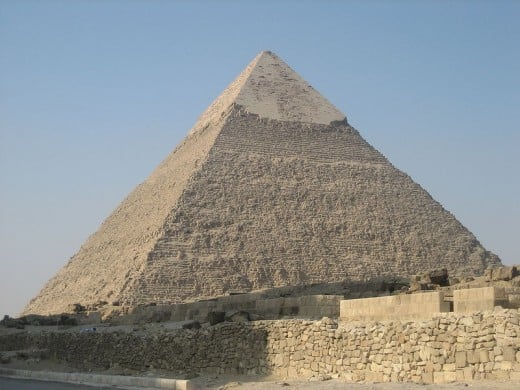
Precision
The final problem to be solved is that of precision. The dimensions of the Great Pyramid are nearly perfect, and the stones are so tightly positioned that not even a human hair will fit between some of them. Even assuming the ancient Egyptians could have lifted the stones to the necessary heights, how could they have positioned them with such precision?
As it turns out, this is actually not much of a mystery. Archaeologists have uncovered a number of tools, including set squares, plumb lines, and other tools that would have allowed Egyptian stone masons with enough patience to create stones with perfectly flat, straight surfaces and corners with perfect right angles. It is likely that skilled masons were on site to hand-finish each stone to perfection just before putting it into place.

References

Extraterrestrials
What about aliens? This is a popular theory in some circles, but the truth is that there's just no evidence to support it. The "proof" that is usually offered is simply an assertion that it would have been impossible for the ancient Egyptians to have built the pyramids. Proponents of this theory insist that the technology to move and place such large, heavy stones with such precision didn't exist on earth at that time.
But this is simply not true. As we've discussed, the ancient Egyptians clearly had the capacity to do the job. We don't know the exact details of the system that was used, but we know it would not have been an impossible task for them. They could have done it - without the help of aliens.
Believe me, no one would be happier than I to see proof of extraterrestrial intelligence. Unfortunately, it appears as though the pyramids at Giza are not that proof.

References
- Brier, Bob and Houdin, Jean-Pierre. The Secret of the Great Pyramid. New York, Harper Perennial, 2009.
- Jonathan Stamp and Steven Manuel, Writers. Building the Great Pyramid. BBC Television, 2002.
- Robert Alexander, Editor. Unlocking the Great Pyramid. PSL Productions LTD. for National Geographic Channel, 2008
- Science Daily. How Were The Egyptian Pyramids Built? http://www.sciencedaily.com/releases/2008/03/080328104302.htm
- Archaeology. How to Build a Pyramid. http://www.archaeology.org/0705/etc/pyramid.html
- National Science Foundation. The Surprising Truth Behind the Construction of the Great Pyramids. http://www.nsf.gov/discoveries/disc_summ.jsp?cntn_id=109692&org=NSF






